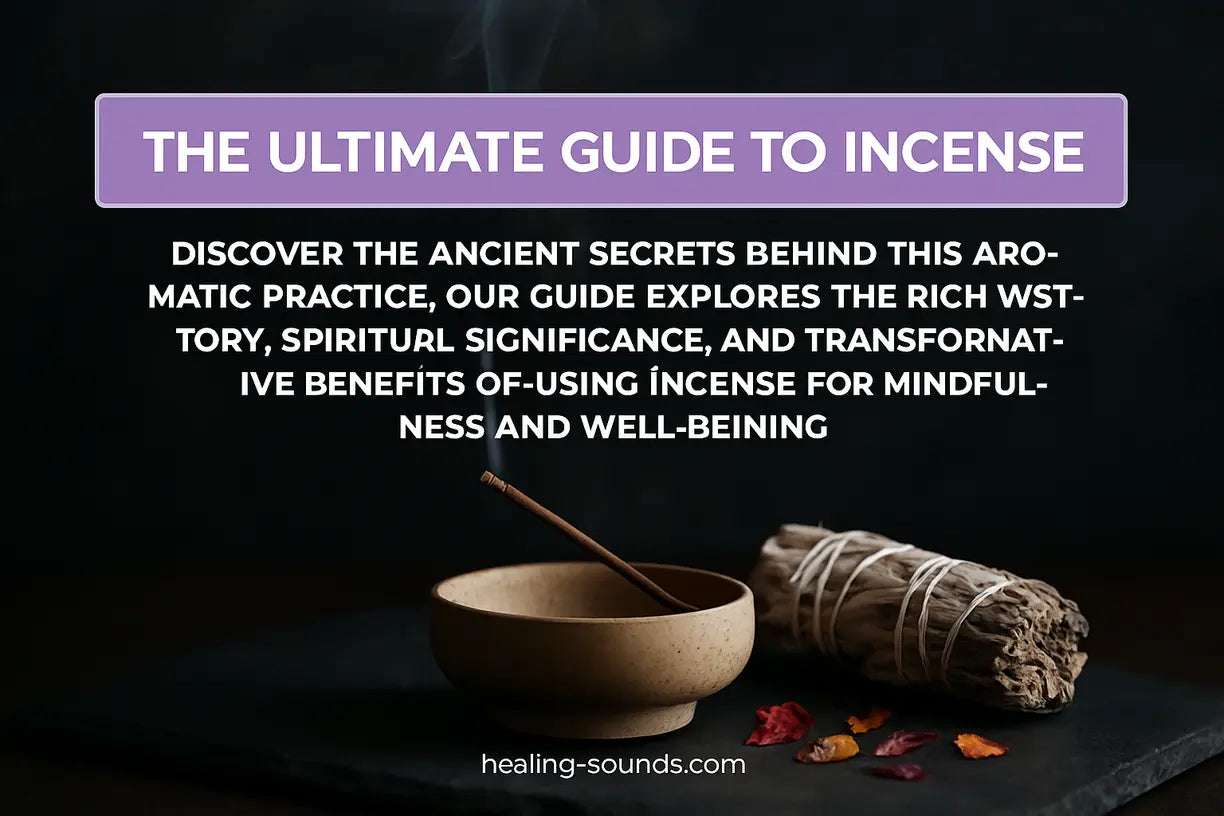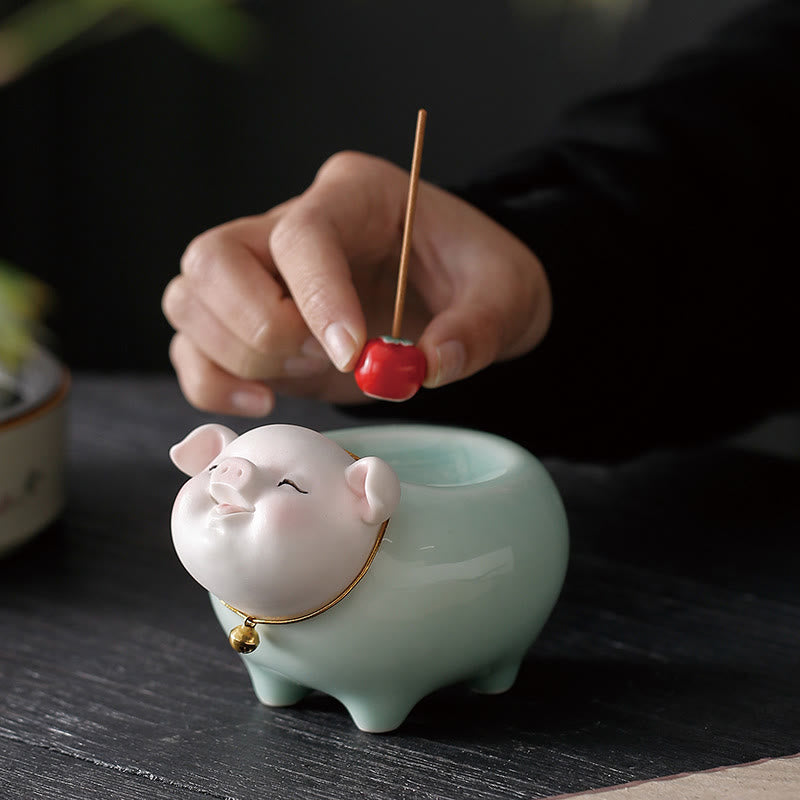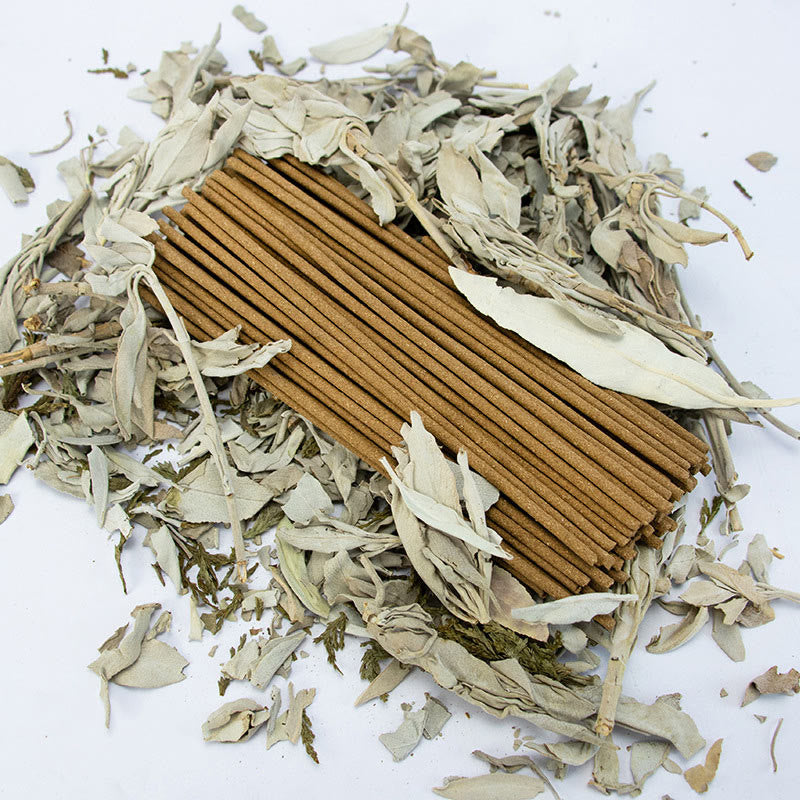Sanfte Rauchwolken, ein beschwörender Duft, der einen Raum erfüllt – seit Jahrhunderten ist Weihrauch ein wirksames Mittel, um einen einfachen Raum in ein heiliges Heiligtum zu verwandeln. Das Verbrennen von Weihrauch ist mehr als nur ein angenehmer Duft. Es ist ein Ritual, das den Geist erdet, den Verstand klärt und mit einer langen Tradition spiritueller Tradition verbindet. Wenn Sie sich schon einmal von dieser uralten Praxis angezogen gefühlt und sich gefragt haben: „Was ist Weihrauch eigentlich?“, sind Sie hier genau richtig.
Dieser umfassende Leitfaden erkundet die wahre Bedeutung von Weihrauch , seine tiefgreifenden Vorteile für Ihr Wohlbefinden und wie Sie ihn ganz einfach in Ihren Alltag integrieren können. Machen Sie sich bereit, die Geheimnisse dieses aromatischen Wunders zu lüften und zu entdecken, wie es Ihre Achtsamkeitsreise bereichern kann.
Die grundlegende Frage: Was ist Weihrauch?
Im Wesentlichen ist Weihrauch ein biologisches Material, das beim Verbrennen aromatischen Rauch freisetzt . Er wird aus einer Kombination pflanzlicher Inhaltsstoffe hergestellt, die seit Jahrtausenden in verschiedenen Kulturen und spirituellen Traditionen verwendet werden, von den Tempeln des alten Ägypten bis zu den Klöstern Tibets. Sein Zweck war schon immer vielfältig: Er diente der Reinigung von Räumen, als Opfergabe, als Meditationshilfe oder einfach zur Schaffung einer ruhigen und erhebenden Atmosphäre.
Die Geschichte des Weihrauchs ist ein reiches Erbe, das sich durch fast alle großen Zivilisationen zieht. Er wurde in religiösen Zeremonien verwendet, wegen seiner vermeintlichen medizinischen Eigenschaften und um den Lauf der Zeit zu markieren. Dieses bleibende Erbe zeugt von seiner universellen Anziehungskraft und seinem tiefgreifenden Einfluss auf die menschliche Erfahrung.
Woraus besteht Weihrauch?
Die Zusammensetzung von Weihrauch ist ein schönes Beispiel für die Alchemie der Natur. Obwohl die Rezepte variieren, besteht der Großteil des Weihrauchs aus wenigen Schlüsselkomponenten. Wenn man versteht, woraus Weihrauch besteht, erkennt man seine reine und erdige Herkunft.
Zu den Hauptzutaten gehören:
- Aromatische Pflanzen und Harze: Dies ist das Herzstück des Weihrauchs. Materialien wie Weihrauch, Myrrhe, Sandelholz, Palo Santo, Salbei und Kopal sorgen für den unverwechselbaren Duft.
- Hölzer und Rinden: Gemahlene Hölzer wie Sandelholz oder Zeder verstärken nicht nur den Duft, sondern sorgen auch dafür, dass das Räucherwerk gleichmäßig brennt.
- Kräuter und Gewürze: Zutaten wie Zimt, Nelken und Lavendel können aufgrund ihrer einzigartigen aromatischen Eigenschaften hinzugefügt werden.
- Eine brennbare Basis: Ein Bindemittel, oft ein natürlicher Gummi oder Holzkohlepulver, hält die Zutaten zusammen und lässt sie langsam schwelen, anstatt schnell zu verbrennen.

Die spirituelle Bedeutung und Symbolik des Räucherns
Über seine physischen Eigenschaften hinaus hat das Räuchern eine spirituelle Bedeutung. Für viele ist es ein heiliges Ritual, das Energie reinigt und positive Gedanken fördert. Die Bedeutung des Räucherns wird oft mit dem Element Luft in Verbindung gebracht und verbindet das Irdische mit dem Spirituellen.
Der aufsteigende Rauch gilt weithin als Symbol für Gebete, Absichten und Wünsche, die zum Göttlichen aufsteigen. Wenn sich der Rauch auflöst, soll er negative Energie abtransportieren, den Raum reinigen und eine Schutzbarriere bilden. Das macht ihn zu einem unschätzbar wertvollen Hilfsmittel für Meditation, Gebet oder einfach zum Setzen einer positiven Absicht für den Tag. Er verwandelt Ihre Umgebung und macht sie zu einem förderlichen Ort für Selbstbeobachtung und spirituelle Verbindung.
Die Vorteile des Räucherns entdecken
Welche Wirkung hat Weihrauch auf Körper, Geist und Seele? Die Vorteile sind vielfältig und können Ihr tägliches Wohlbefinden deutlich steigern. Diese einfache Praxis kann Ihnen helfen, ein friedlicheres und ausgeglicheneres Leben zu führen.
- Reduziert Stress und Angst: Bestimmte Aromen wie Sandelholz und Lavendel haben nachweislich eine beruhigende Wirkung auf das Nervensystem, helfen, Spannungen abzubauen und die Entspannung zu fördern .
- Verbessert die Konzentration bei der Meditation: Das Ritual des Anzündens von Räucherstäbchen kann Ihrem Gehirn signalisieren, dass es Zeit ist, langsamer zu werden und sich zu konzentrieren. Der Duft wirkt wie ein sanfter Anker für Ihre Aufmerksamkeit während der Meditation.
- Fördert die Achtsamkeit: Wenn Sie Ihren Geruchssinn aktivieren, sind Sie direkt im gegenwärtigen Moment und können Ihre Umgebung bewusster und achtsamer wahrnehmen.
- Reinigt und klärt Ihren Raum: Düfte wie weißer Salbei und Palo Santo werden traditionell verwendet, um stagnierende oder negative Energie aus einem Raum zu entfernen und ihm ein frisches und erneuertes Gefühl zu verleihen.
- Fördert die Kreativität: Ein angenehmer Duft kann den Geist anregen und dabei helfen, kreative Blockaden zu überwinden. Er ist daher ein toller Begleiter beim Tagebuchschreiben, Malen oder anderen künstlerischen Unterfangen.
Um tiefer in die unglaublichen Vorteile dieser Praxis einzutauchen, bietet das folgende Video einen wunderbaren Überblick über die wichtigsten Vorteile, die Sie erleben können.
[Sammlungs-Schieberegler]
Die verschiedenen Arten von Weihrauch entdecken
Räucherstäbchen gibt es in verschiedenen Formen, die jeweils ein einzigartiges Erlebnis bieten. Obwohl es viele verschiedene Stile gibt, lassen sie sich im Allgemeinen in zwei Hauptkategorien einteilen: direkt und indirekt brennendes Räucherstäbchen. Wenn Sie die verschiedenen Räucherstäbchenarten kennen, können Sie das perfekte Räucherstäbchen für Ihre Bedürfnisse auswählen.

Direkt brennendes Räucherwerk (brennbar)
Dies ist die häufigste und benutzerfreundlichste Art von Räucherwerk. Es wird mit einer brennbaren Basis hergestellt, d. h. es kann nach dem Anzünden von selbst glimmen und brennen. Die beliebtesten Formen sind:
- Stäbchen: Diese bestehen aus einem dünnen Bambuskern, der mit Räuchermaterial überzogen ist, oder sind feste Stäbchen aus Räuchermaterial selbst.
- Kegel: Diese kleinen, kegelförmigen Räucherkegel brennen relativ schnell ab und geben einen konzentrierten Duft ab. Einige sind als „Rückflusskegel“ konzipiert, bei denen der Rauch wie ein Wasserfall nach unten fließt.
- Spiralen: Diese haben eine Spiralform und können sehr lange brennen, was sie ideal für ausgedehnte Zeremonien oder Veranstaltungen macht.
Um diese Räucherarten sicher und schön genießen zu können, ist ein geeigneter Halter unerlässlich. Ein Räuchergefäß fängt nicht nur die Asche auf, sondern trägt auch zur Ästhetik Ihres heiligen Raumes bei und wird so zu einem Teil des Rituals.
Räucherstäbchenhalter aus Keramik in Form eines kleinen Schweinchens, 9 cm
$59.90 $85.90
Verschönern Sie Ihren Raum mit diesem bezaubernden Räuchergefäß aus Keramik in Schweineform, das Ihrem Ritual perfekt einen Hauch von Verspieltheit verleiht.
Produkt entdeckenIndirekt brennendes Räucherwerk (nicht brennbar)
Diese Art von Räucherwerk wird aus reinen Harzen, Kräutern oder Hölzern ohne brennbare Basis hergestellt. Es benötigt eine separate Wärmequelle, um sein Aroma freizusetzen, typischerweise eine heiße Kohlescheibe in einem hitzebeständigen Räuchergefäß oder einer Schale. Diese Form enthält Rohstoffe wie Weihrauchharz, Kopal und Myrrhe . Obwohl es etwas mehr Vorbereitung erfordert, wird es von vielen Kennern wegen seines reinen, unverfälschten Duftes geschätzt.
So verwenden Sie Weihrauch: Eine einfache Anleitung zum Ritual
Der Umgang mit Räucherwerk ist einfach und schön. Es bietet die Möglichkeit, langsamer zu werden und bewusster zu handeln. Folgen Sie diesen Schritten, um Ihr eigenes Räucherritual zu beginnen.
- Wählen Sie Ihre Absicht: Bevor Sie beginnen, entscheiden Sie sich für den Zweck Ihres Rituals. Soll es Entspannung, Reinigung, Konzentration oder etwas anderes sein? Wählen Sie ein Räucherwerk, das zu Ihrem Ziel passt.
- Bereiten Sie Ihren Raum vor: Suchen Sie sich einen ruhigen, gut belüfteten Bereich. Platzieren Sie Ihr Räucherstäbchen oder Ihren Räucherkegel sicher in einem dafür vorgesehenen Räucherstäbchenhalter oder -brenner auf einer hitzebeständigen Oberfläche.
- Zünden Sie das Räucherstäbchen an: Halten Sie ein Feuerzeug oder Streichholz an die Spitze des Räucherstäbchens oder -kegels. Halten Sie die Flamme einige Sekunden lang, bis die Spitze rot zu glühen beginnt.

- Flamme löschen: Pusten Sie die Flamme vorsichtig aus. Sie sollten einen stetigen Strom duftenden Rauchs aus der glühenden Glut aufsteigen sehen.
- Genießen und bewusst sein: Lehnen Sie sich zurück und genießen Sie das beruhigende Aroma. Lassen Sie sich vom Duft im Hier und Jetzt erden. Beobachten Sie den sanften Tanz des Rauchs, der Ihren Raum erfüllt.
- Sicherheitshinweise: Lassen Sie brennendes Räucherstäbchen niemals unbeaufsichtigt. Halten Sie es von brennbaren Gegenständen, Kindern und Haustieren fern. Sorgen Sie für eine ausreichende Luftzirkulation im Raum.
Wesentliches für Ihr Räucherritual
$27.90
$39.90
Reinigen Sie Ihr Zuhause und steigern Sie Ihre Meditation mit diesen natürlichen Räucherstäbchen aus weißem Salbei, die für reinen, aromatischen Rauch hergestellt wurden. Mehr erfahren ➔
$39.90
$57.90
Bringen Sie Ruhe in Ihr Zuhause mit diesem wunderschön gefertigten Fischerboot aus violettem Ton, einem Symbol für Frieden und Geduld. Mehr erfahren ➔
Begeben Sie sich auf die Reise des Duftes
Räucherwerk ist weit mehr als nur ein Raumduft; es ist ein uralter Schlüssel zu tieferem Frieden, Achtsamkeit und spirituellem Bewusstsein. Von seinem natürlichen Ursprung bis zu seiner tiefen symbolischen Bedeutung bietet es eine einfache, aber kraftvolle Möglichkeit, Ihre Umgebung und Ihre Denkweise zu verändern. Wenn Sie seine Vorteile und Anwendungsmöglichkeiten verstehen, können Sie beginnen, Ihre eigenen persönlichen Rituale zu entwickeln, die Ruhe und Zielstrebigkeit in Ihren Alltag bringen.
Wir laden Sie ein, die Welt des Weihrauchs zu erkunden und die Düfte und Werkzeuge zu finden, die Ihren Geist ansprechen. Lassen Sie sich vom sanften Rauch zu einem zentrierteren und gelasseneren Seinszustand führen.
Häufig gestellte Fragen zu Weihrauch
Weihrauch ist eine Substanz aus aromatischen Pflanzenstoffen, die beim Verbrennen wohlriechenden Rauch freisetzt. Er wird für eine Vielzahl von Zwecken verwendet, darunter spirituelle Zeremonien, Aromatherapie, Meditation, die Reinigung eines Raumes von negativer Energie und die Schaffung einer beruhigenden und angenehmen Atmosphäre im Haus.
Spirituell gesehen ist das Verbrennen von Weihrauch ein heiliges Ritual. Der aufsteigende Rauch wird oft als Symbol gesehen, das Gebete und Absichten zum Göttlichen oder zum Himmel trägt. Er wird verwendet, um einen Raum von negativer Energie zu reinigen, das spirituelle Bewusstsein zu stärken und eine heilige Umgebung für Gebet, Meditation und andere Rituale zu schaffen.
Die beiden Hauptarten sind direkt brennendes und indirekt brennendes Räucherwerk . Direkt brennendes Räucherwerk (wie Stäbchen und Kegel) hat eine brennbare Basis und kann nach dem Anzünden von selbst glimmen. Indirekt brennendes Räucherwerk (wie Rohharze) hat keine brennbare Basis und benötigt eine konstante externe Wärmequelle, wie beispielsweise eine Kohlescheibe, um sein Aroma freizusetzen.
Nein, Weihrauch ist nicht ausschließlich mit Hexerei verbunden. Obwohl er in Wicca und anderen modernen Hexereipraktiken verwendet wird, erstreckt sich seine Verwendung über Tausende von Jahren in unzähligen Kulturen und Religionen, darunter Buddhismus, Hinduismus, Christentum sowie altägyptische und römische Zeremonien. Weihrauch ist ein universelles spirituelles Werkzeug, nicht eines, das durch eine einzelne Praxis definiert ist.
Weihrauch wird in der Bibel häufig erwähnt, insbesondere im Alten Testament. Er war ein wichtiger Bestandteil der Anbetung in der Stiftshütte und im Tempel, wo eine spezielle Mischung als Opfergabe an Gott auf einem goldenen Altar verbrannt wurde (Exodus 30:34-38). In den Psalmen und der Offenbarung dient der Weihrauch als Symbol für die Gebete der Heiligen, die zu Gott aufsteigen. Weitere Einzelheiten zur historischen religiösen Verwendung finden Sie in Quellen wie der Britannica .







